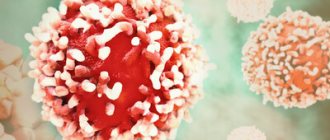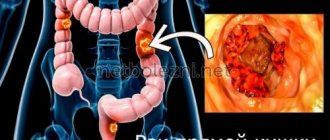Hemicolectomy is a surgical procedure performed to treat various diseases of the large intestine. During the operation, resection of the colon is performed along with the efferent and afferent segments; in case of a malignant process, lymphadenectomy is also performed - removal of regional lymph nodes. In addition, the final stage of surgery is reconstruction - the formation of a colorectal anastomosis by suturing the end sections of the transverse colon and ileum for the normal passage of intestinal contents. In some cases, a colostomy is formed - removal of the end of the intestine to the anterior abdominal wall; reconstructive surgery to reduce the intestinal stoma to normalize intestinal patency can be prescribed after 2-3 months.
Depending on the location of the pathology and the part of the colon to be removed, right-sided or left-sided hemicolectomy is distinguished. If the focus of the pathology is either in the ascending colon, or in the terminal part of the ileum, or in the cecum or right transverse colon, a right hemicolectomy is performed; this option is more common. When a tumor is diagnosed in the distal part of the transverse part, in the descending part and the proximal part of the sigmoid colon, a left hemicolectomy is prescribed.
Depending on the stage of the disease, the operation can be performed by open laparotomy or laparoscopy. In our clinic, surgeons always strive to perform surgery using a gentle method, therefore, if possible, laparoscopic hemicolectomy is performed. Also, in 90% of our patients, during the operation, a primary anastomosis is formed to preserve the natural passage of intestinal contents.
Find out the cost by phone: +7 (495) 782-50-10
Duration 2.5-3 hours.
Time in hospital 10-13 days
Indications and contraindications
Indications
- tumors;
- intestinal obstruction;
- intestinal bleeding;
- perforation;
- Crohn's disease, ulcerative colitis;
- common polyposis;
- complicated diverticulosis;
- surgery as palliative treatment;
Contraindications
- multiple distant metastases;
- some blood diseases;
- infectious and inflammatory processes in the tissues of the abdominal wall;
- concomitant diseases in the stage of decompensation (cardiopulmonary, diabetes mellitus, renal, liver failure, etc.)
Preparing for surgery
Before the operation, endoscopy of the large intestine (colonoscopy or sigmoidoscopy) is performed, during which, if indicated, a tissue biopsy is performed from the source of the disease to confirm the diagnosis. If it is impossible to use endoscopic techniques, irrigoscopy is performed - X-ray contrast examination of the intestine with barium administered through an enema. For malignant neoplasms, the examination plan is supplemented with computed tomography and other diagnostic methods to clarify the extent of tumor spread. A general clinical examination before hemicolectomy includes a general blood test, a general urinalysis, determination of blood group, biochemical blood test, fluorography, Wasserman reaction, ECG, consultation with a cardiologist, and, if necessary, other specialists.
Before a planned hemicolectomy, preoperative preparation is carried out, including correction of water and electrolyte metabolism and nutritional deficiencies. If necessary, treatment of concomitant diseases is prescribed in order to achieve a state of remission or compensation. In addition, before hemicolectomy it is necessary to prevent infectious complications with antibiotics. Intestinal cleansing begins in advance. To do this, the day before surgery, the patient is allowed to drink only clear liquids (water, broth, soup), laxatives are prescribed, and enemas are given. In some cases, the enema is repeated in the morning directly on the day of surgery. Before the intervention, the patient needs to take a hygienic shower.
Doctor's comment
If you are undergoing a hemicolectomy and are experiencing understandable anxiety associated with surgery, you should know that the operation is performed under anesthesia. Our clinic uses only modern techniques and drugs for anesthesia, so patients do not experience pain either during the procedure or after it. In addition, in 90% of cases we manage to do without an intestinal stoma; during the procedure, a colorectal anastomosis is formed, so the function of natural movement of intestinal contents and emptying is preserved. If the optimal solution is the formation of a temporary colostomy, reconstructive surgery is prescribed after 2-3 months. For diseases of the large intestine, both the choice of treatment method and the result depend on how thoroughly the diagnosis is carried out. At our clinic you can undergo a comprehensive examination - in a short time and without tiring queues. Do not delay your visit to the doctor, make an appointment; a timely operation significantly increases the chances of minimally traumatic treatment and a quick recovery.
Head of the surgical service at SwissClinic Konstantin Viktorovich Puchkov
Combination treatment, targeted therapy for colon cancer
In addition to the surgical method, radiation therapy (irradiation) and chemotherapy (administration of special drugs) are used to improve prognosis and effectiveness.
Chemotherapy and radiation may be used as primary treatment for advanced forms of colon cancer when radical treatment is not possible. Methods can improve the patient’s condition, reduce the risk of bleeding, and reduce pain.
Many studies have shown that colon adenocarcinomas are highly sensitive to betatron bremsstrahlung radiation. Telegammatherapy is also used. It is most advisable to irradiate locally advanced tumors.
The most commonly used chemotherapy drugs are eloxatin (oxaliplatin), 5-fluorouracil + leucovorin, Irinotecan, Tomudex (raltitrixide), Campto (irinotecan), Ftorafur, Capecitabine.
The newest method of influencing the tumor focus is targeted therapy for colon cancer. Cetuximab and panitumumab are some of the high-tech drugs used in this technique. These are monoclonal antibodies that specifically destroy malignant cells. Their use makes it possible to reduce the toxic effects and side effects of chemotherapy drugs.
Why is it better to have a hemicolectomy at the Swiss University Hospital?
- The clinic’s surgeons were among the first to begin performing minimally invasive operations on the intestines; each specialist has performed more than 600 successfully performed surgical interventions.
- During the operation, we use the most modern techniques and equipment, for example, to reduce blood loss, the LigaSure device (USA), ultrasonic scissors, absorbable suture material, modern stitching devices that minimize the risk of complications in the postoperative period, etc.
- Our Center was one of the first to begin performing simultaneous (one-step) operations: in the presence of concomitant pathologies, one anesthesia can get rid of several diseases at once.
- We have the opportunity to undergo a high-quality and comprehensive examination, the clinic is equipped with the most innovative expert-class equipment, and the reception is conducted by experienced specialists of the highest or first category. Every year we consult more than 5,000 people, and more than 5 thousand types of research are available to patients.
Rehabilitation
The patient's recovery takes place in the intensive care unit under the supervision of doctors. If the course is favorable, the drainage is removed on days 3-5, and the sutures are removed on days 8-10. In some cases, after six months it is possible to restore intestinal continuity and eliminate the colostomy.
Find out more information by phone or fill out the online form - the administrator will contact you to confirm your appointment.
SM-Clinic guarantees complete confidentiality of your request.
FAQ
What is the preparation for a hemicolectomy?
When choosing the optimal treatment method for intestinal diseases, careful diagnosis is important, since the prognosis directly depends on the chosen treatment tactics. To suppress microflora, a few days before the planned operation, the doctor may prescribe antibiotics, taking into account the sensitivity of the intestinal flora. If the patient is taking any medications, the doctor should be informed about this, and some of them may need to be temporarily excluded. Three days before the intervention, you should avoid foods that increase gas formation (vegetables, fruits, bread, etc.). On the eve of the operation - a cleansing enema. Last meal - 8 hours or more.
How is a hemicolectomy performed?
The operation consists of three stages: identifying the focus of pathology (tumor), removing regional lymph nodes and forming a colorectal anastomosis. However, the operation cannot always be performed simultaneously; in some cases, in order to reduce the load on the anastomosis formed during the operation, it is necessary to apply a colostomy to divert the intestinal contents. The intestinal stoma is sutured after 2-3 months. To prevent thrombosis and thromboembolism, the clinic uses, in addition to compression hosiery, intraoperative controlled pneumatic compression SCD Response.
Why does a hemicolectomy require removing a large portion of the intestine?
During the intervention, not only the tumor itself is removed, but also the afferent and efferent segment of the intestine. This is due to several features. In accordance with the principles of oncological treatment, the tumor is removed within healthy tissue, which means the need to resection a part of the intestine 5-10 cm from the source of pathology; also, in case of a malignant process, it is important to remove the lymph nodes with the tumor en bloc. In addition, it is necessary to take into account the peculiarities of the blood supply; parts of the large intestine are supplied with blood by different branches of the blood supply; when ligating one of them, the corresponding part of the intestine will be cut off from the blood supply.
What can a patient expect after a hemicolectomy?
In the first days, the patient may be bothered by intestinal dysfunction, but such disorders are quite amenable to correction. Persistent adaptation occurs after a few months, a person adapts to the diet and gets used to the diet, body weight normalizes, etc. In the long-term period after surgery, due to the absence of part of the colon, the patient may experience some digestive disorders: insufficient absorption of nutrients, vitamins, and microelements. Therefore, in the future, a person should adhere to the diet recommended by the doctor. In order to promptly notice and prevent possible violations, a person needs to regularly visit a doctor.
Types of hemicolectomy surgery - what are they?
In addition to the fact that, depending on the localization of the process, right-sided and left-sided hemicolectomy are distinguished, there are also different methods of performing the operation. Surgery can be performed openly through a midline incision in the abdominal wall. There is also a less traumatic method - laparoscopic hemicolectomy, when all manipulations are performed using video endoscopic equipment through several small incisions. The possibility of detailed visualization, a short recovery period and excellent cosmetic results are the main advantages of laparoscopy.
Are there any disadvantages to hemicolectomy?
In some cases, the end part of the intestine must be brought to the anterior abdominal wall - a stoma is formed. Patients have to use a colostomy bag placed around the stoma. A colostomy can be temporary or permanent. In our clinic, an anastomosis is formed in 90% of patients; in only a small part of the operated patients, a temporary stoma is installed - while the intestine heals; later, reconstruction is carried out - connecting the remaining parts of the intestine, which allows the person to go to the toilet naturally.
Are complications possible during hemicolectomy and what are they?
As with other operations, with hemicolectomy there is a risk of developing undesirable consequences: bleeding, damage to nearby tissues, however, performing manipulations under the visual control of modern video equipment reduces the risk to a minimum. In the early postoperative period, the development of peritonitis associated with both infection and failure of the anastomotic sutures cannot be ruled out. Intestinal paresis and obstruction, thromboembolic complications are also possible. In the long-term period, there is a risk of developing adhesive disease, the appearance of a postoperative hernia, cicatricial narrowing of the intestine, and impaired bowel function.
Features of the rehabilitation period after hemicolectomy surgery
Patients can get out of bed on the day of surgery, the next day the operated person can take liquid food, and the diet expands gradually. The length of hospitalization is 5-13 days and depends on the type of intervention; with laparoscopy, the rehabilitation period is shorter. Full recovery will take about two months. Depending on the result of histological analysis, the patient may require chemotherapy. For the first two months after surgical treatment, a person must adhere to a strict diet, gradually expanding his diet. In the future, all operated patients should regularly visit the doctor in order to promptly detect signs of relapse. The prognosis depends on the stage at which the disease was detected and the extent of treatment provided.
Colon Cancer Symptoms
With colon cancer, symptoms may not appear at all in the early stages.
The most common signs of the disease at stages 2-4:
- Discharge of mucus, blood, mucopurulent discharge from the anus.
- Abdominal pain of various types.
- Alternating constipation with short-term diarrhea (diarrhea).
- Tenesmus (unproductive, painful urge to defecate).
- General intoxication (loss of appetite, weight, slight increase in body temperature, weakness).
Photo: image of the large intestine, its sections
There are conditional forms of cancer (malignant neoplasms) of the colon, identified by the presence of the most pronounced initial manifestations.
Toxic-anemic form . Signs of colon cancer with intoxication and the development of anemia predominate. This form is characteristic of a malignant neoplasm of the ascending section, the first part of the colon.
With this type of colon cancer, the first symptoms are nonspecific:
- weakness;
- low-grade fever (frequent, unmotivated rise in temperature up to 380C);
- increased fatigue;
- decrease in blood hemoglobin;
- signs of anemia (may be pallor, shortness of breath, rapid heartbeat, increased sweating).
Obstructive form. With this form of colon cancer, symptoms at the very beginning appear from a decrease (obstruction) of the intestinal lumen:
- pain (usually dull, with the development of the disease it becomes paroxysmal, similar to intestinal “colic”);
- increasing, persistent constipation;
- alternation of short-term diarrhea with long-term constipation;
- increased peristalsis, bloating, rumbling in the stomach;
- gas retention.
Increasing intestinal obstruction is manifested by cramping pain, cramps in the abdomen, after which bowel movement is possible with temporary relief of well-being. Patients often resort to auxiliary aids (enemas). However, the growing tumor leads to complete blockage of the intestine and complete intestinal obstruction develops.
Due to the growth of the cancerous tumor and the involvement of the underlying organs, the clinical forms of the disease may replace each other, and other symptoms may appear:
- weight loss;
- pseudo-inflammatory manifestations simulating appendicitis, cholecystitis and other acute pathologies in the abdominal cavity;
- the appearance of a tumor-like formation in the abdomen (an atypical, tumor form of colon cancer may be characterized by a large tumor, determined upon examination without significant accompanying symptoms).









